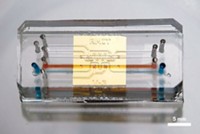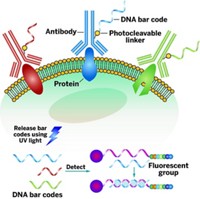Advertisement
Grab your lab coat. Let's get started
Welcome!
Welcome!
Create an account below to get 6 C&EN articles per month, receive newsletters and more - all free.
It seems this is your first time logging in online. Please enter the following information to continue.
As an ACS member you automatically get access to this site. All we need is few more details to create your reading experience.
Not you? Sign in with a different account.
Not you? Sign in with a different account.
ERROR 1
ERROR 1
ERROR 2
ERROR 2
ERROR 2
ERROR 2
ERROR 2
Password and Confirm password must match.
If you have an ACS member number, please enter it here so we can link this account to your membership. (optional)
ERROR 2
ACS values your privacy. By submitting your information, you are gaining access to C&EN and subscribing to our weekly newsletter. We use the information you provide to make your reading experience better, and we will never sell your data to third party members.
Structural Biology
Sensing molecules released from single cells without labels
Combination of microfluidics and a nanosensor achieves label-free detection of cytokines from individual cells
by Cici Zhang
June 5, 2018

Although many bioanalytical methods study the average behavior of cells across a collection, biologists have started to realize that individual cells often act differently than their neighbors. For example, a small minority of cells within a population may respond uniquely to a drug and such differences can affect the efficacy of that agent.
To learn more about such heterogeneity, researchers need to perform single-cell analyses but existing methods to do so usually require multiple steps and the addition of fluorescent labels. Now, a microfluidic device may save time by isolating single cells and detecting cellular secretions without labels (Small 2018, DOI: 10.1002/smll.201800698).
To make the device, an Australian-Swiss team designed a microfluidic chamber to isolate and house a single cell. Under the chamber, a biosensor chip made of gold transmits light at a specific wavelength through plasmonic nanostructures. The chip is coated with antibodies that bind biomolecules called cytokines. As the antibodies capture cytokines, the mass deposited on the chip increases, leading to a shift in the wavelength of the transmitted light. The researchers can analyze the outgoing light and, based on the degree of wavelength shift, calculate how many cytokine molecules were captured.

The team tested the device on single lymphoma cells and found that each cell released different amounts of cytokines in distinct spatial distributions. Cytokines regulate key immune responses and are invovled in autoimmune diseases and cancer.
People have been developing highly sensitive label-free biosensors with similar nanoscale photonics, says corresponding author Hatice Altug of Swiss Federal Institute of Technology, Lausanne (EPFL). But, she says, the new device can analyze single cells. First author Xiaokang Li, also at EPFL, adds that the biosensor could study other cell types by using chips coated with antibodies that bind molecules relevant to a given system.
“This work is interesting because it offers a rare opportunity to monitor protein secretion in real time, without labels, from single cells,” says Rebecca Pompano, a University of Virginia chemist who studies the immune system. The new method, she adds, is complementary to existing ones, which require several hours to complete, and has a sensitivity that is as good as bead-based assays, one of the traditional ways to detect cytokines. Pompano thinks researchers could use the device to “test how immunotherapies or other drugs affect the rates of cytokine secretion from a population of single immune cells.”
One possible application the researchers envision is early detection of cancer through analysis of blood droplets. “[The device] would be able to select all the cells that were of interest,” and then analyze their molecular secretions to identify cancerous cells, says author Arnan Mitchell of RMIT University.




Join the conversation
Contact the reporter
Submit a Letter to the Editor for publication
Engage with us on Twitter